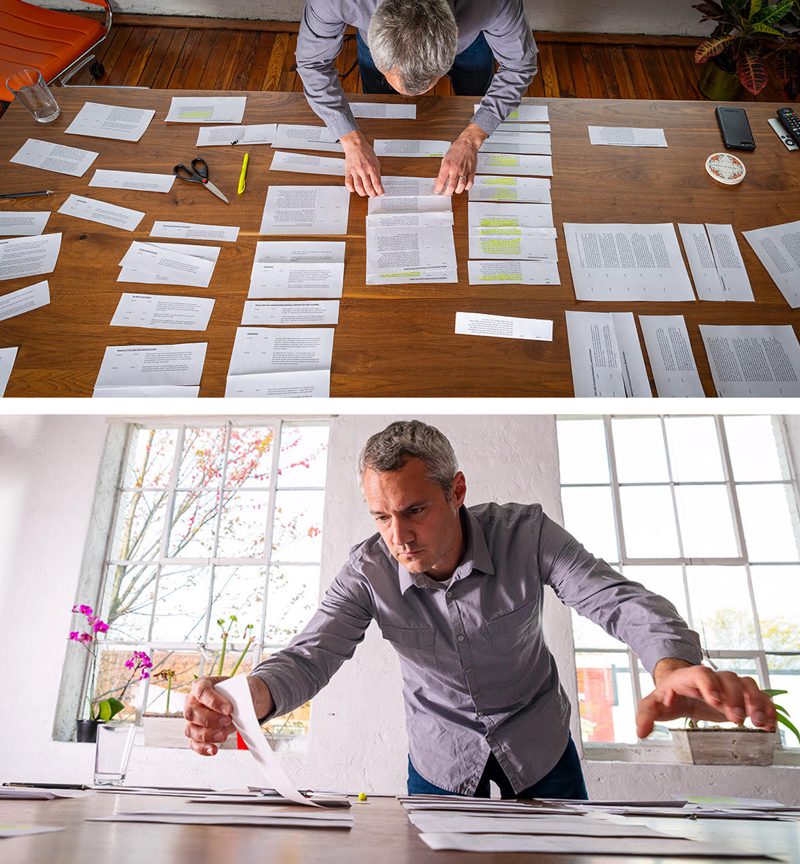Even for a digital storyteller like David Wilson, sometimes paper just makes more sense.
After all of the filming and recording is done, the gear is put away, and the footage is imported, a stack of interview transcripts awaits our director of videography on the office printer. He grabs a highlighter and a pair of scissors, and soon, slips of paper cover the conference table. Laser-focused, Dave studies each interview quote as he cuts them apart, creating careful piles. Then more piles. Is this my intro? Would this be a good transition? A line of papers begins to emerge, snaking through the other scattered pieces.
A story is beginning to take shape.
At Tigermoth, “story” is our Golden Rule. Everyone has one. Everything needs one. And it always comes first, no matter the medium or client.
This is clear when you see one of our finished products. Take the brand video Dave created for family-owned furniture company Kravet Design, for example. Like his videos for other clients, it delivers a beginning that hooks you, a middle that gets you invested, and an ending that leaves you inspired and ready to act.
When I first started working with Dave on some of his videos, I learned that the “story” doesn’t just emerge in the final piece — it permeates every stage of his process, which involves collaborating with the client and engaging with the material in ways I didn’t expect. Before coming to Tigermoth, I associated brand videos with cue cards, scripts and storyboards. And while those things have their place, Dave’s process is rooted in a kind of authenticity that means the exact content of the final piece can’t be predicted. And that’s a good thing.
His process starts with a single goal — to discover and understand yours. When approaching his project with Kravet, Dave knew he was telling the story of a family that had been in business for 100 years. And he knew the key points that he needed to hit — design, history, passion. In partnership with the client, he decided that the best story, the most authentic story, would emerge by showcasing the family.
This meant an interview. A conversation. Listening.
To Dave, the interview is an artform of its own
Dave’s expertise lies in helping our clients reveal their story by guiding them through telling it themselves.
It begins with location, in this case, setting up the interview on the design floor instead of in a corporate office. Before even clipping the lavalier microphone to Scott’s collar and pressing record to film the interview for the Kravet video, Dave had the CEO talk about things that inspired him and got him going every day with questions as simple as, “Why do you love fabric?”
“You can’t go in knowing the answers to what they’re going to say,” Dave says. “You go in knowing what the goal is, and you go in with curiosity. When you sit down and talk to them, you’re pulling the story out of them. It takes a lot of conversation and back and forth and finding different stories that won’t make it to the video.”
Or, to sum it up more simply: “The story unfolds, and we capture it.”
According to Dave, there comes a point in the interview where you just know you’ve heard it. It. The story. A gut instinct like that — the natural, inner guide of a seasoned storyteller — is a hard thing to explain or teach. But while the camera’s rolling, he’s already making a mental catalogue of the most important moments as they happen. These are the moments that will anchor the rest.
“I remember the things that are important in the interview because they were important to the person who was telling the story.”
Stitching together your story — a simple yet “freaking brilliant” part of our process
Director of Creative Writing Andrea Spencer also knows a thing or two about constructing a story — and her role is crucial in the video process, both her day-to-day collaboration with Dave on narrative, scripts and on-screen text, as well as in how he started cutting up transcripts by hand in the first place. A suggestion from Andrea gave way to a revelation by Dave. Being able to see everything at once and physically manipulate the order and groups of papers was “freaking brilliant,” he says.
 Stepping away from the computer means it’s easier for Dave to continue letting curiosity drive the editing process. He sees himself as a guide, letting their words tell the story and just trying to find the best pieces that have the “why.”
Stepping away from the computer means it’s easier for Dave to continue letting curiosity drive the editing process. He sees himself as a guide, letting their words tell the story and just trying to find the best pieces that have the “why.”
“I like the physical and visual aspect of having the quotes on paper, being able to cut them out and highlight them, and see when it falls into place,” Dave says. “Things just start making sense and the story is telling itself.”
The quotes that stay on the table are stitched together, along with b-roll, music, and often images and text. Sometimes Dave shoots the b-roll before the interview, to prompt his subject to talk about what he filmed. With Kravet, he shot the b-roll after the interview to illustrate Scott’s words.
I’ve heard artists who work with clay and stone say that the hunk of raw material has something hidden inside — it already knows what it wants to be and it will tell you. Dave is a carver with a mountain of marble. As he chips away at extraneous quotes and b-roll, the story is revealed in its most authentic and impactful form — and he is giddy with excitement.
“I love when clients say, ‘I can’t wait to see it when it’s done!’ and I say, ‘I can’t wait either!’” Dave says. “I don’t know what it will look like. It could go 10 different directions to chase 10 different stories. I can’t wait to dive in and see where the story takes me.”

